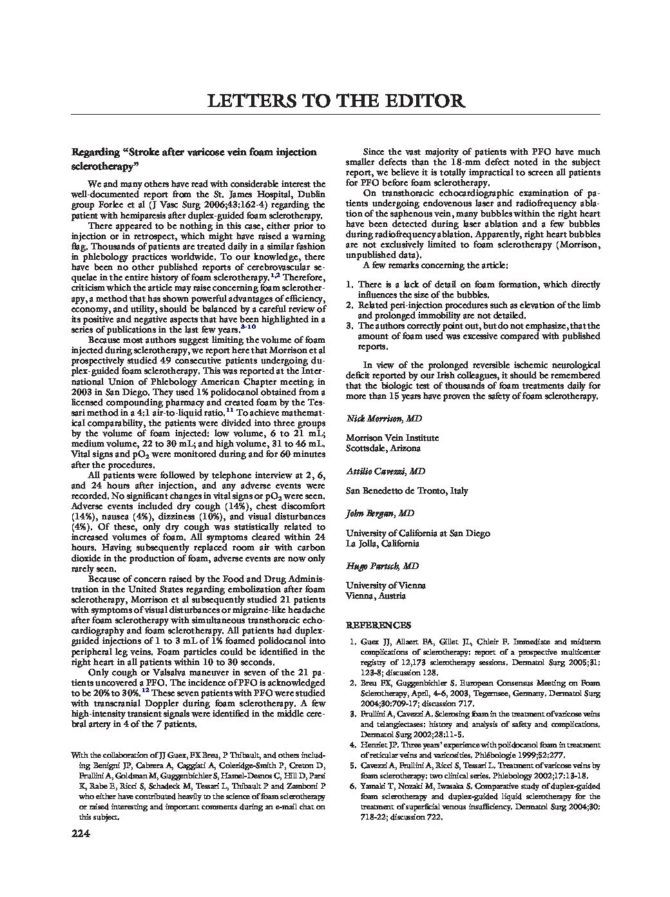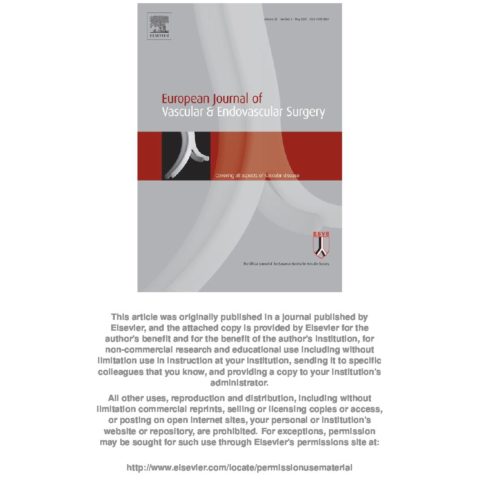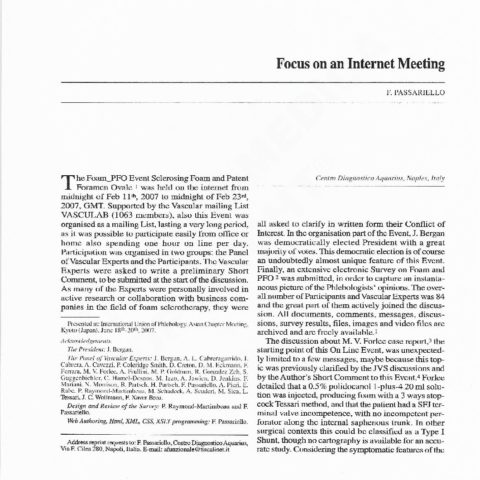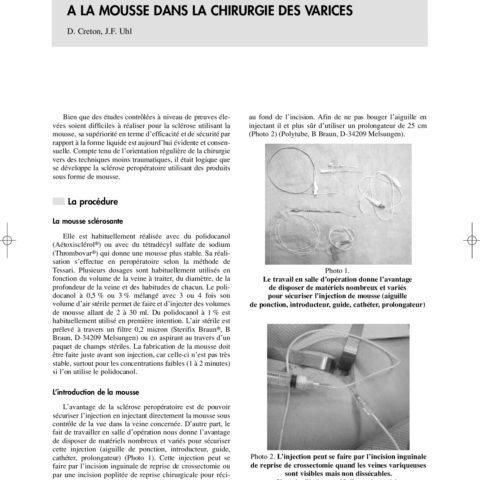Regarding « Stroke after varicose vein foam injection sclerotherapy »

Regarding « Stroke after varicose vein foam injection sclerotherapy »
We and many others have read with considerable interest the well-documented report from the St. James Hospital, Dublin group Forlee et al (J Vasc Surg 2006;43:162-4) regarding the patient with hemiparesis after duplex-guided foam sclerotherapy. There appeared to be nothing in this case, either prior to injection or in retrospect, which might have raised a warning flag. Thousands of patients are treated daily in a similar fashion in phlebology practices worldwide. To our knowledge, there have been no other published reports of cerebrovascular sequelae in the entire history of foam sclerotherapy.1,2 Therefore, criticism which the article may raise concerning foam sclerotherapy, a method that has shown powerful advantages of efficiency, economy, and utility, should be balanced by a careful review of its positive and negative aspects that have been highlighted in a series of publications in the last few years.3-10 Because most authors suggest limiting the volume of foam injected during sclerotherapy, we report here that Morrison et al prospectively studied 49 consecutive patients undergoing duplex- guided foam sclerotherapy. This was reported at the International
Union of Phlebology American Chapter meeting in 2003 in San Diego. They used 1% polidocanol obtained from a licensed compounding pharmacy and created foam by the Tessari method in a 4:1 air-to-liquid ratio.11 To achieve mathematical comparability, the patients were divided into three groups by the volume of foam injected: low volume, 6 to 21 mL; medium volume, 22 to 30 mL; and high volume, 31 to 46 mL. Vital signs and pO2 were monitored during and for 60 minutes
after the procedures. All patients were followed by telephone interview at 2, 6, and 24 hours after injection, and any adverse events were recorded. No significant changes in vital signs or pO2 were seen. Adverse events included dry cough (14%), chest discomfort (14%), nausea (4%), dizziness (10%), and visual disturbances (4%). Of these, only dry cough was statistically related to increased volumes of foam. All symptoms cleared within 24 hours. Having subsequently replaced room air with carbon dioxide in the production of foam, adverse events are now only rarely seen.
Because of concern raised by the Food and Drug Administration in the United States regarding embolization after foam sclerotherapy, Morrison et al subsequently studied 21 patients with symptoms of visual disturbances or migraine-like headache after foam sclerotherapy with simultaneous transthoracic echocardiography and foam sclerotherapy. All patients had duplexguided injections of 1 to 3 mL of 1% foamed polidocanol into peripheral leg veins. Foam particles could be identified in the right heart in all patients within 10 to 30 seconds. Only cough or Valsalva maneuver in seven of the 21 patients uncovered a PFO. The incidence of PFO is acknowledged to be 20% to 30%.12 These seven patients with PFO were studied with transcranial Doppler during foam sclerotherapy. A few high-intensity transient signals were identified in the middle cerebral artery in 4 of the 7 patients.
Since the vast majority of patients with PFO have much smaller defects than the 18-mm defect noted in the subject report, we believe it is totally impractical to screen all patients for PFO before foam sclerotherapy. On transthoracic echocardiographic examination of patients undergoing endovenous laser and radiofrequency ablation of the saphenous vein, many bubbles within the right heart have been detected during laser ablation and a few bubbles during radiofrequency ablation. Apparently, right heart bubbles are not exclusively limited to foam sclerotherapy (Morrison, unpublished data).
A few remarks concerning the article:
- There is a lack of detail on foam formation, which directly influences the size of the bubbles.
- Related peri-injection procedures such as elevation of the limb and prolonged immobility are not detailed.
- The authors correctly point out, but do not emphasize, that the amount of foam used was excessive compared with published reports.
In view of the prolonged reversible ischemic neurological deficit reported by our Irish colleagues, it should be remembered that the biologic test of thousands of foam treatments daily for more than 15 years have proven the safety of foam sclerotherapy.
AUTHORS
Nick Morrison, MD
Morrison Vein Institute Scottsdale, Arizona
Attilio Cavezzi, MD
San Benedetto de Tronto, Italy
John Bergan, MD
University of California at San Diego La Jolla, California
Hugo Partsch, MD
University of Vienna Vienna, Austria
With the collaboration of JJ Guex, FX Breu, P Thibault, and others including Benigni JP, Cabrera A, Caggiati A, Coleridge-Smith P, Creton D, Frullini A, Goldman M, Guggenbichler S, Hamel-Desnos C, Hill D, Parsi K, Rabe E, Ricci S, Schadeck M, Tessari L, Thibault P and Zamboni P who either have contributed heavily to the science of foam sclerotherapy or raised interesting and important comments during an e-mail chat on this subject.
REFERENCES
- Guex JJ, Allaert FA, Gillet JL, Chleir F. Immediate and midterm complications of sclerotherapy: report of a prospective multicenter registry of 12,173 sclerotherapy sessions. Dermatol Surg 2005;31: 123-8; discussion 128.
- Breu FX, Guggenbichler S. European Consensus Meeting on Foam Sclerotherapy, April, 4-6, 2003, Tegernsee, Germany. Dermatol Surg 2004;30:709-17; discussion 717.
- Frullini A, Cavezzi A. Sclerosing foam in the treatment of varicose veins and telangiectases: history and analysis of safety and complications. Dermatol Surg 2002;28:11-5.
- Henriet JP. Three years’ experience with polidocanol foam in treatment of reticular veins and varicosities. Phlébologie 1999;52:277.
- Cavezzi A, Frullini A, Ricci S, Tessari L. Treatment of varicose veins by foam sclerotherapy: two clinical series. Phlebology 2002;17:13-18.
- Yamaki T, Nozaki M, Iwasaka S. Comparative study of duplex-guided foam sclerotherapy and duplex-guided liquid sclerotherapy for the treatment of superficial venous insufficiency. Dermatol Surg 2004;30: 718-22; discussion 722.
- Barrett JM, Allen B, Ockelford A, Goldman MP. Microfoam ultrasoundguided sclerotherapy of varicose veins in 100 legs. Dermatol Surg 2004; 30:6-12.
- Hamel-Desnos C, Desnos P, Wollmann JC, Ouvry P, Mako S, Allaert FA. Evaluation of the efficacy of polidocanol in the form of foam compared with liquid form in sclerotherapy of the greater saphenous vein: initial results. Dermatol Surg 2003;29:1170-5; discussion 1175.
- Barrett JM, Allen B, Ockelford A, Goldman MP. Microfoam ultrasoundguided sclerotherapy treatment for varicose veins in a subgroup with diameters at the junction of 10mmor greater compared with a subgroup of less than 10 mm. Dermatol Surg 2004;30:1386-90.
- Bergan J, Pascarella L, Mekenas L. Venous disorders: treatment with sclerosant foam. J Cardiovasc Surg (Torino) 2006;47:9-18.
- Tessari L. Nouvelle technique d’ obtention de la scléro-mousse. Phlebologie 2000;53:129.
- Meier B, Lock JE. Contemporary management of patent foramen ovale. Circulation 2003;107:5-9.
| Date | 2006 |
| Auteurs | J Vasc Surg 2006;44:224-5 Morisson N, Cavezzi A, Bergan JJ, Partsch H. Creton D as contributor. Letter to the editor. |






